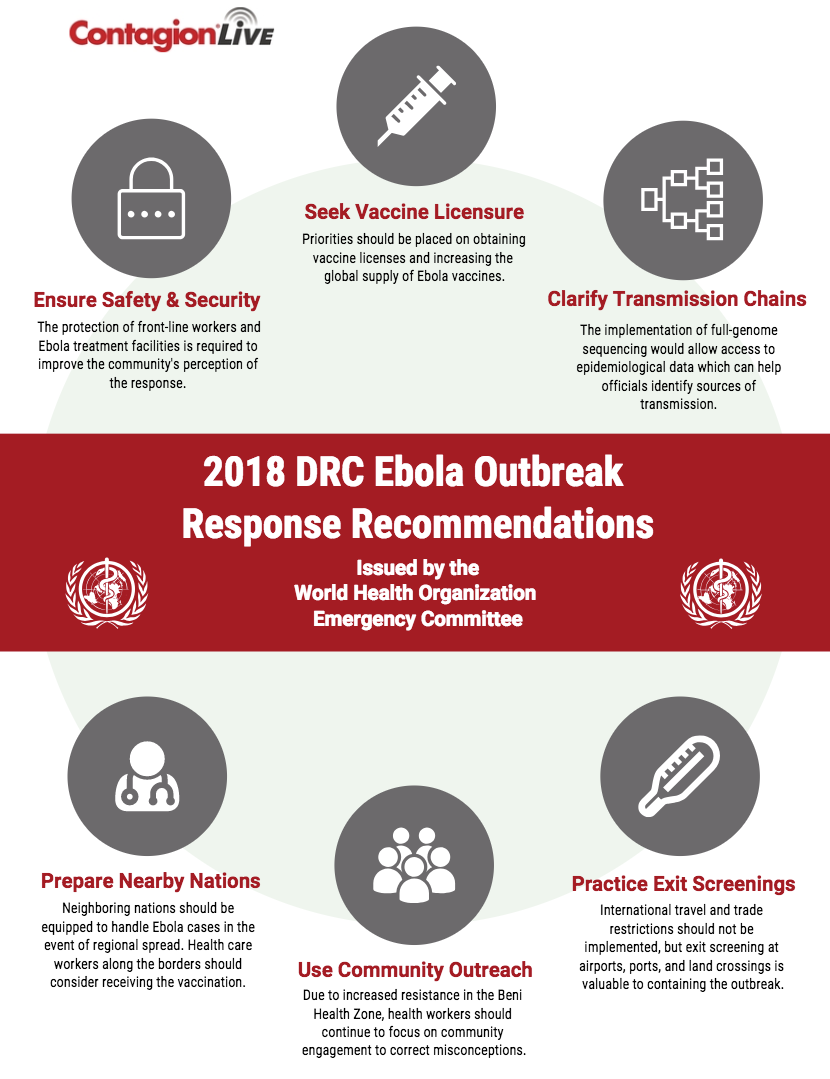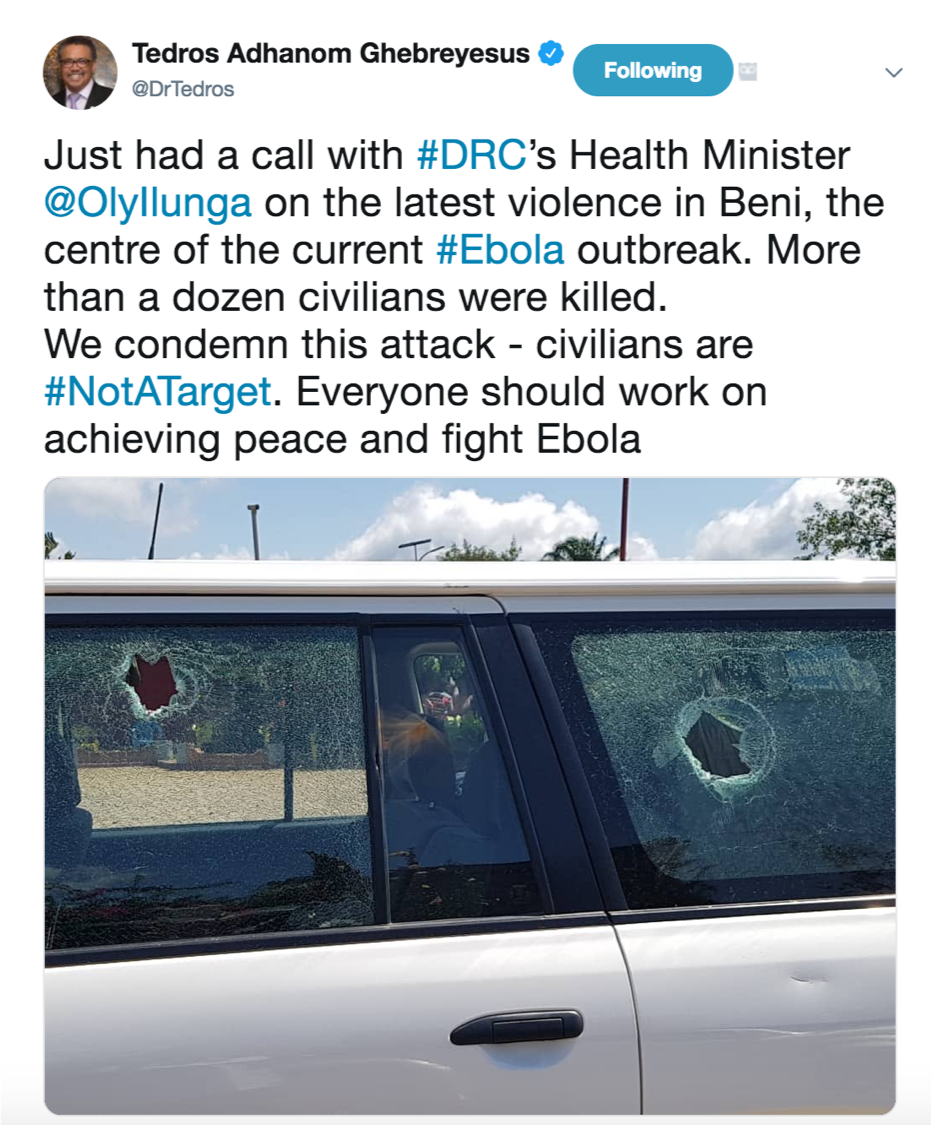Security Concerns and Case Counts Rise As Ebola Outbreak Rages On
The new epicenter of the outbreak is the Beni Health Zone in which 66% of the new cases have been reported since September.
Updated November 1, 2018 at 4:34 PM EDT
The Ebola outbreak in the North Kivu Province of the Democratic Republic of the Congo (DRC) currently stands as the fourth largest outbreak of Ebola in the country’s history.
As of October 31, 2018, there have been a total of 285 cases of Ebola in the region (250 laboratory-confirmed cases and 35 probable cases) and 145 confirmed deaths. As it stands, the global fatality ratio among confirmed cases in 73.2%.
Tedros Adhanom Ghebreyesus, PhD, Director-General of the World Health Organization (WHO) previously assembled an emergency meeting to decide if the outbreak constitutes a public health emergency of international concern (PHEIC) and on October 17, 2018, the emergency committee decided that the outbreak is not a PHEIC at this time. In response to the challenges faced in this outbreak, the committee issued public health advice (see infographic).
The current outbreak has been wreaking havoc on the region since August and reported cases have been on the rise as violence has also spread throughout the region by armed groups. Violence in the Beni Health Zone has disrupted surveillance and prevention activities, suspending services for many days.
Dr. Ghebreyesus, vehemently condemned the latest attacks on Twitter (see tweet):
Since September, it is estimated that 66% of all newly reported cases have been in Beni and the health zone now has 76 confirmed cases and 47 confirmed deaths. The region has surpassed the Mangina Health Zone to become the epicenter of the outbreak.
According to the WHO’s latest Disease Outbreak News report, the latest violent incidents “are occurring amidst intense EVD transmission in communities in the city of Beni.”
In addition to the violence in Beni, an attack on 3 local Red Cross workers in the city of Butembo on October 2, 2018, led to the suspension of safe dignified burial activities in the city until further notice.
Because of the increase in violent events, the US Centers for Disease Control and Prevention (CDC) has relocated CDC health workers that were volunteering in violent areas, effectively pulling the workers from areas with the most need.
“In this DRC outbreak of Ebola, there are security risks to public health responders in the field that have not been present in past outbreaks,” Tom Inglesby, MD, director of the Center for Health Security of the Johns Hopkins Bloomberg School of Public Health said in an interview with Contagion®. “One of the consequences of this is that CDC has had to pull back its people from the field. Every time CDC or other organizations have had to pull people out of the field, there is less capacity to trace contacts, less capacity to do vaccination programs, less people to communicate with communities about how they can lessen their own risks.”
In a new approach to increase community engagement and surveillance integration, members of the community in 12 neighborhoods across the Beni Health Zone have partnered with health workers to promote prevention methods. The community members will arrive on-site prior to the health workers who are conducting surveillance, contact tracing, and vaccination administration, to engage with the individuals and address questions or concerns.
This method has been implemented in the Beni Health Zone because it has the highest number of contacts and has experienced the greatest amount of resistance from residents. In one instance, an individual fled a treatment center after being diagnosed with Ebola in Beni, greatly raising the risk to those who may come in contact with the individual and thus, spreading the disease. This is the exact situation health care officials want to avoid.
In spite of the growing number of cases and armed conflict, outbreak response efforts remain underway.
According to an October 15 report from the DRC Ministry of Health, 73 patients have been treated with the experimental therapies mAb 114, Remdesivir, Zmapp or Regeneron in this outbreak. A total of 32 of these patients have recovered and 20 remain currently hospitalized. Twenty-one of these patients have died.
Furthermore, health workers from the Red Cross have successfully responded to 190 safe and dignified burial alerts. When carried out correctly, these burial practices reduce the risk of transmission of Ebola virus to healthy individuals.
At this time, no cases of Ebola virus have been reported in any of the nations surrounding the DRC. The bordering nations remain on high alert and vaccination preparedness strategies are being implemented in Uganda, South Sudan, Rwanda, and Burundi as a precaution.
This is an ongoing outbreak and Contagion® will continue to provide updates as they become available.
For the most recent case counts associated with the Tenth Ebola Outbreak in the DRC, check out the Contagion® Outbreak Monitor.


